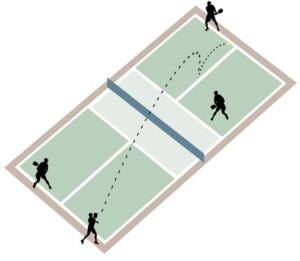- Both players on the serving doubles team have the opportunity to serve and score points until they commit a fault *(except for the first service sequence of each new game).
- The first serve of each side-out is made from the right/even court.
- If a point is scored, the server switches sides and the server initiates the next serve from the left/odd court.
- As subsequent points are scored, the server continues switching back and forth until a fault is committed, and the first server loses the serve.
- When the first server loses the serve the partner then serves from their correct side of the court (except for the first service sequence of the game*).
- The second server continues serving until his team commits a fault and loses the serve to the opposing team.
- Once the service goes to the opposition (at side out), the first serve is from the right/even court and both players on that team have the opportunity to serve and score points until their team commits two faults.
- In singles the server serves from the right/even court when his or her score is even and from the left/odd when the score is odd.
*At the beginning of each new game only one partner on the serving team has the opportunity to serve before faulting, after which the service passes to the receiving team.


